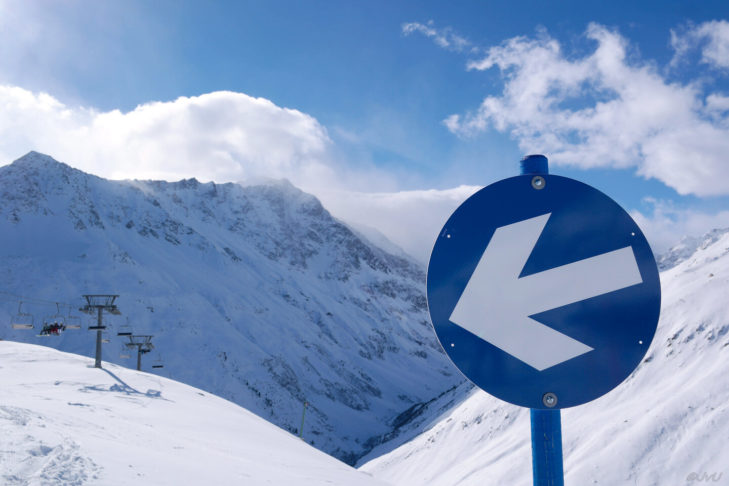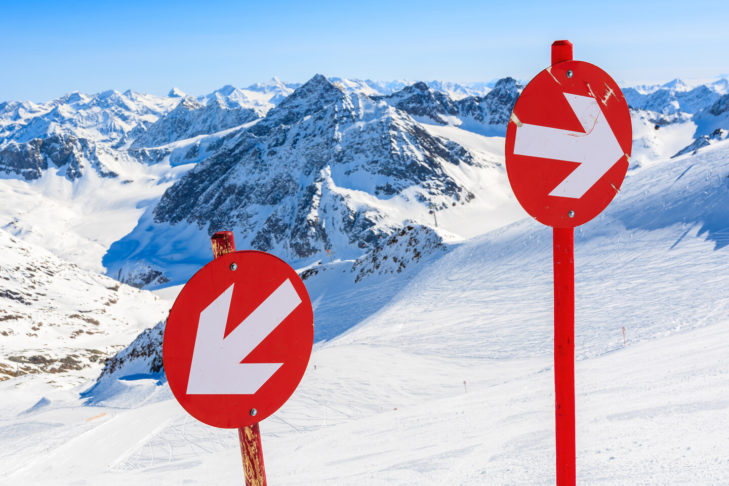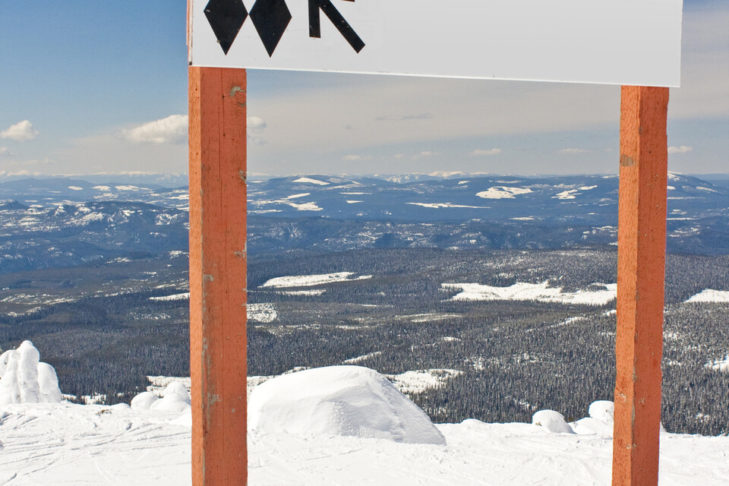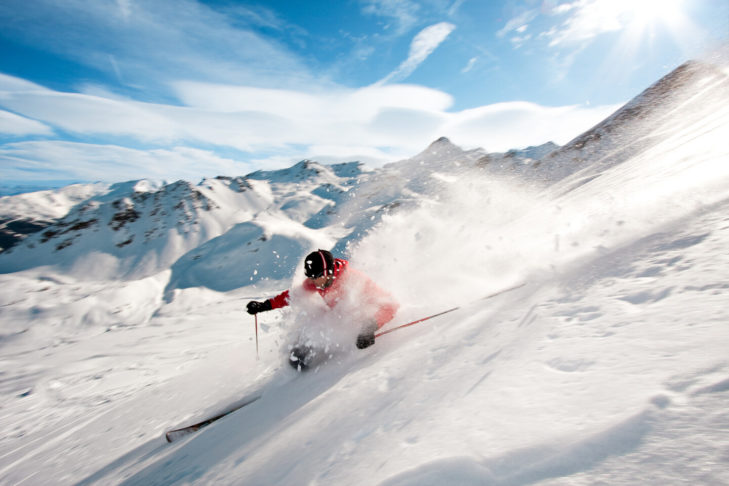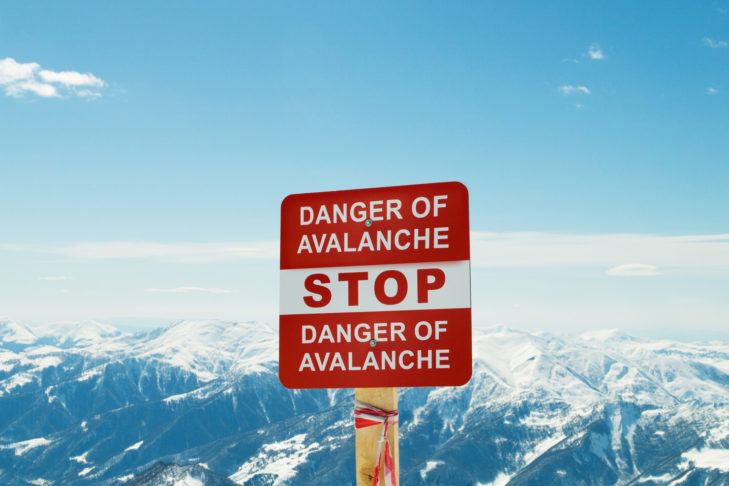If you ski, you will not only see white snow, but also green, red, blue, black and sometimes even diamonds. This is because every ski resort in the world marks the difficulty level of the slopes with certain colours or symbols in slope markers. What the ski slope colors mean in detail, how they differ from country to country and why they do not show the difficulty of a piste alone is explained below.
Diamonds and colours: How to recognise the difficulty of the slopes
The first orientation in a ski area is provided by the piste guidance systems. They show a general overview of the pistes, lifts and connecting routes in the ski area, as well as information on nature reserves and closed areas. These guidance systems are designed to provide winter sports enthusiasts with clear orientation in ski areas right from the start.
In extensive ski areas, pistes sometimes have their own numbers or names. Especially when there are many pistes with many connections, this helps winter sports enthusiasts stay on the right piste.
In addition, individual pistes are classified according to difficulty. In Europe, pistes are categorised in a colour system according to their difficulty. In most Alpine countries, the following colour scheme applies: blue, red and black.
Blue slope
The blue slopes are easy, designed for beginners and have a maximum gradient of 25%. They are also ideal for returning skiers or for trying out or refining new techniques.
Red slope
The red slopes are steeper and narrower compared to the blue runs. They are suitable for experienced beginners and have a maximum gradient of 40%. Experienced skiers also use the red runs to prepare for the more difficult black pistes or, because of the steeper slope, to practise carving techniques.
Black slope
These slopes are considered difficult and are intended for advanced winter sports enthusiasts. As there is no regulation on the gradient of black runs, they can range from very steep to extremely steep. It is recommended that black runs are only skied by skiers who have mastered the short turn. Furthermore, if you have had problems on the red runs, it is better to avoid the black runs. In addition to the colour markings, the boundaries of the slopes are usually marked with poles. These can either have bright signal colours or be the same colour as the level of the piste.
European peculiarities with ski slope colors
The colour system applies to the entire Alpine region, but there are some special features in some countries. In France, for example, there are four colours: green, blue, red and black. The green slopes are for beginners, blue is considered medium, red is difficult and black is very difficult.
The green colour markings are also used in the Scandinavian countries and in Spain. Here, however, a green piste marks beginner and practice hills. The green slopes have a maximum gradient of 16%, the blue slopes have a maximum gradient of 27% and the red slopes can have a gradient of up to 47%. To further distinguish between difficult black runs and more extreme runs, the double black diamond is used in these countries for runs with extreme gradients.
Ski routes and off-pistes
The colour-coded pistes are regularly checked, groomed and protected against avalanches. Regularly means that even in the evening there is still a control on the slopes. So if you get stuck on your own for any reason, you can be sure that help will still be coming on the marked pistes.
The situation is different on the ski routes. In most countries they are marked on coloured signs (usually yellow or orange) as “ski route”. On maps they are marked as a dotted line. They are controlled, but not very regularly. They are also not groomed by snowcats. France is an exception here, as the ski routes there are among the officially controlled areas.
There is also the free ski area, also called terrain or off-piste and sometimes also deep snow area. Here there are neither controls nor ski slope colors. Accordingly, only very experienced skiers should venture onto the off-piste for long tours. It is important to note that in Europe everything beyond the marked piste is considered free skiing. Under certain circumstances, this can even be a drag path from one marked piste to the next.
Japan
In Japan, the European colour code is followed as far as possible. Green stands for easy slopes, red for medium and black for difficult. Most slopes in Japan are marked red.
North America
The North American marking system is also called the “Disney system” because it was designed by Walt Disney. Disney conducted surveys among winter sports enthusiasts to find out which colours and symbols were associated with which level of difficulty. The result was the North American system:
- Green circle: easiest slopes
- Blue square: moderately difficult slopes
- Black diamond: difficult slopes
- Double black diamond: very difficult slopes
- Triple black diamond: extremely difficult slopes
It should be noted that, unlike in Europe, the symbols do not indicate a specific slope. They are always in relation to each other in the respective ski area. A blue square in Montana can therefore have a completely different degree of difficulty than a blue square in Colorado.
In North America, no distinction is made between marked slopes and open ski terrain. Avalanche danger is considered a risk that skiers everywhere have to accept. Nevertheless, not all slopes are prepared in the same way. The groomed slopes are usually protected against avalanches even in North America. Ski routes and off-pistes are divided into frontcountry, slackcountry, sidecountry and backcountry. The frontcountry slopes are close to ski resorts and can be reached by lifts, while the remote back country routes can only be reached under one’s own steam.
New Zealand
New Zealand has adapted a mixture of the North American and European systems. Green indicates easy slopes, but these are usually more difficult compared to the North American green circles. Blue indicates a moderately difficult slope, black a difficult one. In addition, there are double-black and triple-black, which respectively stand for very difficult and extremely difficult slopes.
Summary
The ski slope colors in ski resorts are important for winter sports enthusiasts to identify the difficulty of a piste. However, the international codes are not uniform and should therefore always be checked in advance. Furthermore, they should not be understood as absolute categories: decisive for the difficulty of a piste are also one’s own abilities, the form of the day as well as the external conditions. If you are unsure, it is better to choose an easier slope than to risk an accident. This is the safest way to ski for yourself and everyone else. However, piste markings are not everything! Apart from the piste markings, winter sports enthusiasts must also be able to correctly assess the degrees of difficulty as well as certain external factors such as the weather for their own safety.
FAQs on piste markings and levels of difficulty
Why are ski slopes marked?
Ski slopes are marked to indicate their level of difficulty. In Europe, the colour markings green and blue stand for easy pistes, red for medium and black for difficult ones.
What is a piste guidance system?
Piste guidance systems are overview maps of the entire ski area with a variety of information on pistes, connecting routes, ski lifts and nature conservation and restricted areas. In addition to the piste markings, they provide skiers with an initial orientation over the entire ski area.
Are the piste markings the same all over the world?
No! Markings differ in the European area. For example, France, Spain and the Scandinavian countries have slightly different markings compared to the other Alpine countries. Japan largely follows the European system. North America and New Zealand have their own marking systems. It is therefore important to find out about the systems in advance.
Why can black runs be particularly treacherous?
For black runs, unlike for blue and black runs, there are no regulations on the maximum slope. This means that, depending on the ski area, black runs can vary in steepness and can sometimes be more difficult than expected as a result. It is recommended that only those skiers who have mastered the short turn should venture onto black runs. The rule of thumb is: if you reach your limits on red slopes, you should avoid black slopes.
Is it enough to pay attention to the markings alone?
No! Markings provide an initial orientation, but factors such as weather and visibility conditions as well as your own ability also influence how difficult or easy a descent is.

